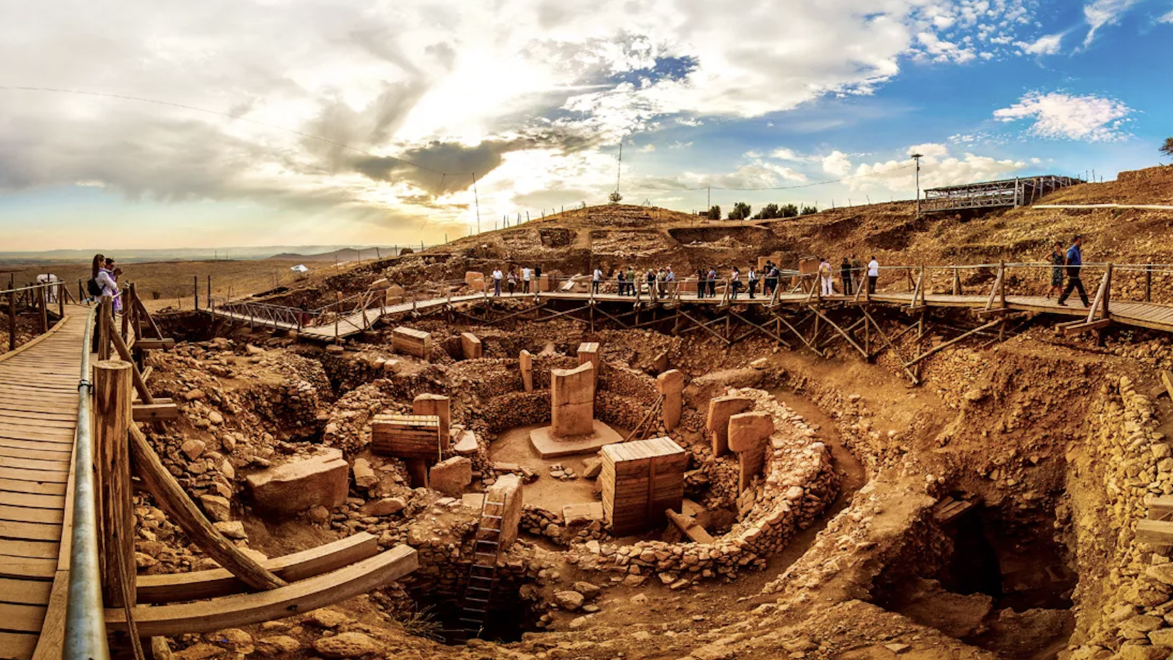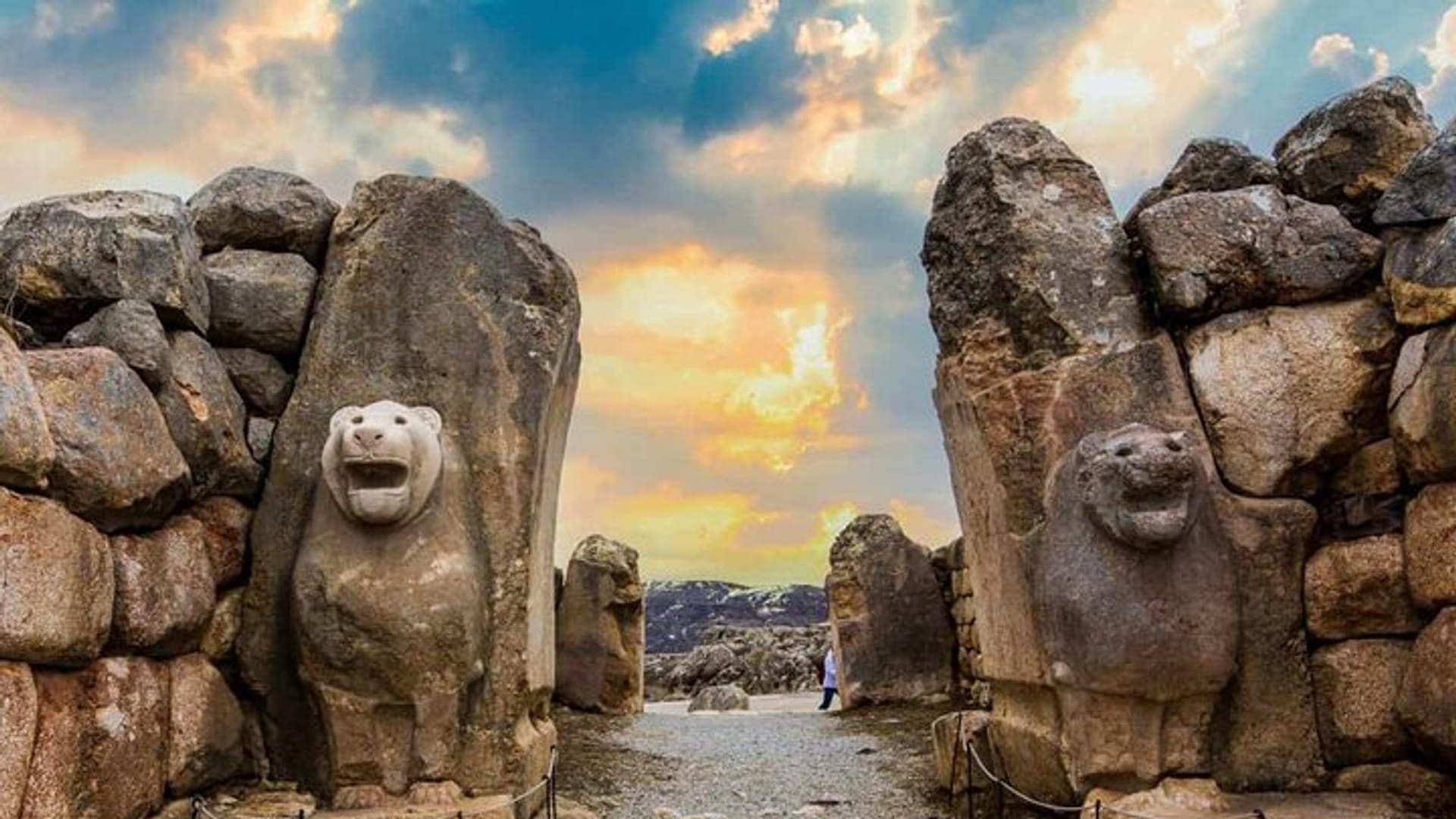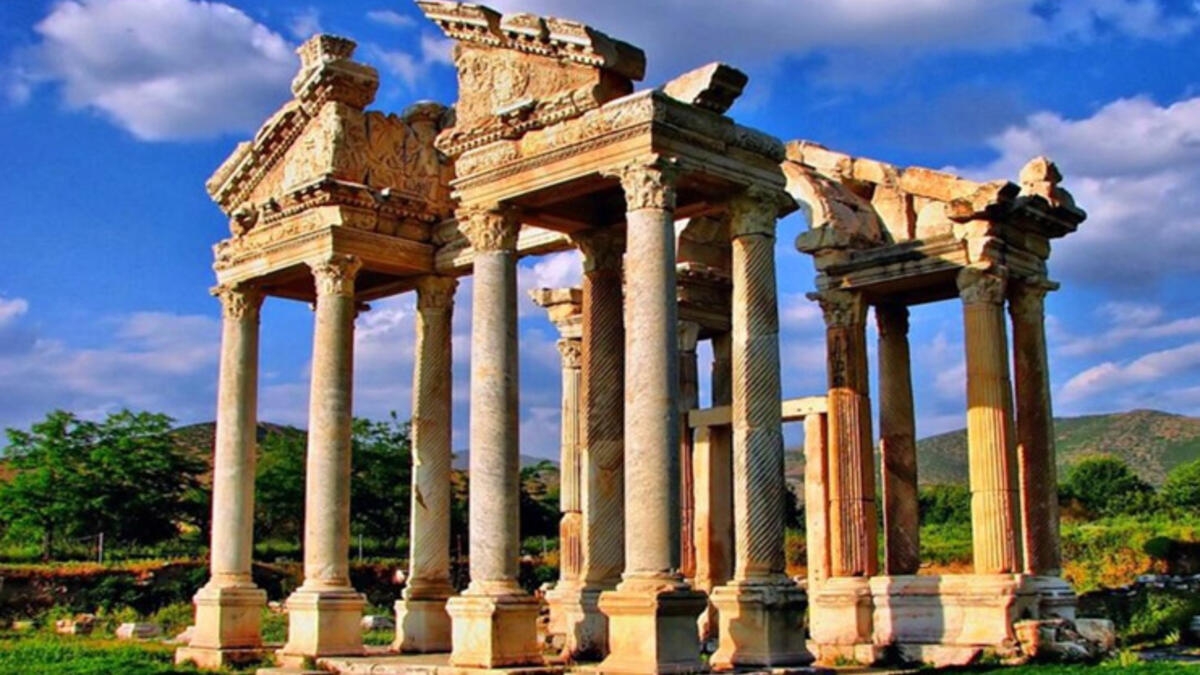Last Updated on 22 elokuun, 2025 by tuula
🏺 Anatolian muinaiset sivilisaatiot: Sivilisaatioiden kehto
Mantereiden ja kulttuurien välissä sijaitseva Anatolia – nykypäivän Turkki – on yksi maapallon historiallisesti rikkaimmista alueista. Anatolian muinaiset sivilisaatiot ovat kukoistaneet täällä yli 10 000 vuotta, mikä tekee alueesta innovaatioiden, imperiumien rakentamisen ja kulttuurivaihdon keskuksen. Sen maantieteellinen sijainti Euroopan ja Aasian risteyksessä teki siitä arvostetun ja kiistellyn maan, joka houkutteli niin uudisasukkaita, sotureita kuin visionäärejäkin.
Göbekli Tepen, ihmiskunnan vanhimman tunnetun uskonnollisen paikan, mystisistä kaiverruksista mahtavaan Bysantin valtakuntaan, Anatolian tarina on muutoksen ja jatkuvuuden tarina. Jokainen sen menneisyyden kerros myötävaikuttaa syvälliseen ja monimutkaiseen perintöön, joka muokkaa edelleen paitsi Turkin, myös koko maailman historiaa.
Tässä kirjoituksessa jäljitämme Anatolian matkaa ajassa – esihistoriallisista pioneereista Bysantin keisareihin – paljastaen muinaiset sivilisaatiot, jotka loivat perustan modernille yhteiskunnalle.
🧬 Esihistoriallinen Anatolia: Asuinalueiden syntymäpaikka
🏡 Neoliittisen kauden alku (n. 10 000 – 5500 eaa.)
Kauan ennen kaupunkeja, kuninkaita tai kirjoitettua kieltä Anatolia loi jo sivilisaation perustan.
📍 Göbekli Tepe (n. 9600 eaa.): Ensimmäinen temppeli
Kaakkois-Turkista läheltä Şanlıurfaa löydetty Göbekli Tepe on mullistanut käsityksemme varhaisesta ihmiselämästä. Tämä rituaalipyhäkkö, joka on 6 000 vuotta vanhempi kuin Stonehenge, koostuu T-muotoisista kivipilareista, joista osa on 6 metriä korkeita ja painaa jopa 20 tonnia.
- Ikonografia: Kettujen, käärmeiden, korppikotkien ja härkien veistokset viittaavat symboliseen ja mahdollisesti hengelliseen kosmologiaan.
- Arkkitehtoninen hienostuneisuus: Kompleksi rakennelma kyseenalaistaa käsityksen siitä, että uskonto seurasi maanviljelyä – se on saattanut edeltää sitä.
Miksi sillä on merkitystä: Göbekli Tepe viittaa järjestäytyneeseen uskontoon ja osuuskuntatyöhön ennen vakiintunutta maanviljelyä, muokaten argeologista teoriaa sosiaalisesta evoluutiosta.
📍 Çatalhöyük (n. 7500 eaa.): Protokaupunkielämä
Nykyaikaisen Konyan lähellä sijaitseva Çatalhöyük edustaa yhtä varhaisimmista tunnetuista kaupunkiyhteisöistä. Sen väkiluvuksi arvioidaan 5 000–8 000, ja siellä on varhaisia esimerkkejä sosiaalisesta organisaatiosta ja taiteesta.
- Arkkitehtuuri: Tiheästi rakennetut savitiilitalot, joihin pääsee kattojen kautta, loivat pesämäisen asutuksen.
- Kulttuurinen syvyys: Freskot, hedelmällisyysveistokset ja tarkoitukselliset hautaukset talojen alle viittaavat hengellisiin uskomusjärjestelmiin ja sukupuolten tasa-arvoon.
- Yhteiskunnallinen tasapaino: Ei selkeää eliittiluokkaa, mikä viittaa suhteellisen tasa-arvoiseen rakenteeseen.
🔍 Vertaileva tilannekuva
| Ominaisuus | Göbekli Tepe | Çatalhöyük |
|---|---|---|
| Paikan tyyppi | Temppeli/Pyhäkkö | Asuinasutus |
| Arvioitu ikä | 11 600 vuotta | 9 500 vuotta |
| Arkkitehtuurityyli | Megaliittiset kivipilarit | Mutatiilitalot |
| Ensisijainen tarkoitus | Uskonnolliset seremoniat | Arkielämä ja yhteisöllinen elämä |

🛡️ Pronssikauden sivilisaatiot (n. 3000–1200 eaa.)
⚒️ Hattilaiset ja heettiläiset: Metallin ja diplomatian mestareita
Anatolian strateginen sijainti teki siitä hedelmällisen maaperän voimakkaille pronssikauden valtioille. Hattilaiset, varhainen anatolialaiskansa, lopulta sulautuivat heettiläisiin, jotka loivat yhden antiikin maailman merkittävimmistä valtakunnista.
🔱 Hettiläisten valtakunta (n. 1600–1178 eaa.)
- Pääkaupunki: Hattusa, laaja linnoituskaupunki, jota ympäröivät monumentaaliset muurit ja portit, mukaan lukien ikoninen Leijonaportti.
- Kieli ja laki: Ensimmäisten indoeurooppalaisten puhujien joukossa heettiläiset laativat varhaisen lakikoodin ja käyttivät akkadia diplomatiassa.
- Sotilaallinen kyvykkyys: Rautaisista aseistaan ja vaunujoukoistaan tunnettuina he olivat pelottavia vastustajia Egyptille ja Assyrialle.
- Globaali diplomatia: Allekirjoittivat Kadešin sopimuksen (1259 eaa.) faarao Ramses II:n kanssa – maailman ensimmäisen kirjatun rauhansopimuksen.
📊 Heettiläisten tärkeimmät panokset
| Innovaatio | Merkitys |
|---|---|
| Rautaiset työkalut ja aseet | Ennustettu siirtyminen rautakauteen |
| Oikeusjärjestelmä | Kodifioidut lait oikeudenmukaisuutta ja hallintoa varten |
| Monikielinen diplomatia | Edistyneet kansainväliset suhteet |
| Kaupunkisuunnittelu | Linnoitetut kaupungit kaavoituksineen ja suunnitteluineen |

🏛️Klassinen antiikki: kreikkalaiset ja roomalaiset Anatoliassa
🏺 Hellenistinen vaikutus (n. 330–30 eaa.)
Aleksanteri Suuren valloituksen jälkeen Anatolia astui hellenistisen kulttuurin kulta-aikaan. Paikalliset Anatolian perinteet yhdistyivät kreikan kieleen, taiteeseen ja uskontoon.
- Kulttuurikeskukset: Kaupungeista, kuten Efesoksesta, Pergamonista ja Sardeesta, tuli älyllisiä ja uskonnollisia keskuksia.
- Synkretismi: Kreikkalaisia jumalia palvottiin paikallisten jumaluuksien rinnalla, ja temppelit lisääntyivät.
- Arkkitehtuuri: Teatterit, kuntosalit ja agorat symboloivat yhteiskunnallista elämää.
📍 Kohokohta: Celsoksen kirjasto Efesoksessa, rakennettu 100-luvulla, on edelleen upea esimerkki roomalais-hellenistisestä fuusiosta.
🦅 Rooman valtakunta (n. 133 eaa. – 395 jaa.)
Pergamonin kuningaskunnan testamentattua Roomalle Anatolia integroitui syvästi Rooman valtakuntaan.
Rooman Anatolian keskeiset piirteet
- Infrastruktuuri: Roomalaiset tiet yhdistivät kaupunkeja ja sotilastukikohtia, mikä helpotti kaupankäyntiä ja liikkumista.
- Kaupunkien kehitys: Kaupungit kukoistivat kylpylöineen, foorumeineen ja amfiteattereineen.
- Uskonto: Aluksi pakanallinen alue näytteli myöhemmin keskeistä roolia kristinuskon nousussa.
| Ominaisuus | Roomalainen Anatolia |
|---|---|
| Hallinto | Rooman provinssijärjestelmä |
| Suuret kaupungit | Ephesus, Antioch, Smyrna |
| Uskonto | Pakanallisuus → Varhaiskristillisyys |
| Infrastruktuuri | Tiet, vesijohdot, amfiteatterit |

✝️ Kristinuskon ja Bysantin nousu
✨ Kristillinen muutos (1.–4. vuosisata jKr.)
Anatolialla oli keskeinen rooli varhaiskristillisessä historiassa:
- Apostolien lähetystyö: Apostoli Paavali saarnasi kaupungeissa, kuten Ikonionissa (Konya), Lystrassa ja Galatiassa.
- Vaino ja itsepintaisuus: Roomalaisten sorroista huolimatta kristilliset yhteisöt säilyivät ja laajenivat.
- Käännekohta: Keisari Konstantinuksen Milanon edikti (313 jKr.) laillisti kristinuskon, mikä merkitsi uuden uskonnollisen aikakauden alkua.
🔎 Hauska fakta: Termiä “kristitty” käytettiin ensimmäisen kerran Antiokiassa (nykyaikainen Antakya).
🏰 Bysantin valtakunta (330–1453 jKr.)
Vuonna 330 Konstantinus I perusti Bysantin uudelleen Konstantinopoliksi ja muutti sen Itä-Rooman (Bysantin) valtakunnan pääkaupungiksi.
🕍 Bysantinuksen tunnusomaiset piirteet
- Uskonto: Itäisen ortodoksisen kristinuskon keskus, jolla oli syvä teologinen ja poliittinen vaikutusvalta.
- Kieli ja hallinto: Kreikankielinen eliitti, jolla oli keskitetty keisarillinen byrokratia.
- Taide ja arkkitehtuuri: Kukoisti keisarien, kuten Justinianuksen I:n alaisuudessa.
🧱 Arkkitehtoninen ihme: Hagia Sophia
Vuonna 537 rakennettu Hagia Sophia oli esimerkki bysanttilaisesta loistosta:
- Muotoilu: Massiivinen kupoli, jota kannattelivat riippuvalaisimet
- Koristelu: Ylellisiä mosaiikkeja, jotka kuvaavat uskonnollisia henkilöitä
- Perintö: Inspiroi myöhempää islamilaista arkkitehtuuria, mukaan lukien ottomaanien moskeijoita
📊 Länsi-Rooma vs. Bysantti
| Ominaisuus | Länsi-Rooman valtakunta | Bysantin valtakunta |
|---|---|---|
| Pääkaupunki | Rooma | Konstantinopoli |
| Kieli | Latina | Kreikka |
| Uskonto | Pakanuus → katolinen | Ortodoksinen kristinusko |
| Aika | 476 jKr | 1453 jKr |

🌍 Anatolian muinaisten sivilisaatioiden perintö: Varhaishistoria
Anatolian eri puolilla nousseet ja kaatuneet sivilisaatiot eivät kadonneet – ne jättivät pysyviä jälkiä.
- Kulttuurifuusio: Heettiläisten laista bysanttilaiseen teologiaan Anatolia on esimerkki kulttuurisesta jatkuvuudesta ja lähentymisestä.
- Uskonnollinen vaikutus: Joidenkin varhaisimpien temppelien, kirkkojen ja myöhemmät moskeijat.
- Nykyaikainen merkitys: Paikat, kuten Göbekli Tepe, Efesos ja Istanbul, ovat edelleen elintärkeitä sekä tieteelliselle että matkailulle.
Nykyään Anatolia on elävä museo, joka paljastaa uusia salaisuuksia jokaisen kaivauksen myötä.
❓ Usein kysytyt kysymykset: Anatolian muinaiset sivilisaatiot ja niiden ymmärtäminen
1. Miksi Anatoliaa kutsutaan “sivilisaatioiden kehdoksi”?
Koska siellä sijaitsi joitakin maailman varhaisimmista asutuksista ja uskonnollisista paikoista, kuten Göbekli Tepe ja Çatalhöyük, kauan ennen Mesopotamian ja Egyptin kukoistusta.
2. Mikä oli heettiläisten rooli maailmanhistoriassa?
He muodostivat yhden ensimmäisistä indoeurooppalaisista valtakunnista, olivat edelläkävijöitä rautametallurgiassa ja allekirjoittivat maailman ensimmäisen rauhansopimuksen.
3. Miten kristinusko levisi Anatoliassa?
Apostolien lähetysmatkojen – erityisesti Paavalin kautta – ja sitkeiden paikallisyhteisöjen kautta. Kaupungit, kuten Antiokia ja Efesos, olivat merkittäviä varhaiskristillisiä keskuksia.
4. Mikä teki bysanttilaisesta arkkitehtuurista niin vaikutusvaltaisen?
Sen kupolien, mosaiikkien ja keskitettyjen kirkkosuunnitelmien käyttö loi perustan itäortodoksiselle ja myöhemmin islamilaiselle arkkitehtuurille.
5. Mikä on Göbekli Tepen merkitys nykyään?
Se kirjoitti historiankirjat uusiksi todistaen, että järjestäytynyt uskonto on peräisin maataloudesta – kyseenalaistaen pitkään vallinneet oletukset varhaisesta sivilisaatiosta.




